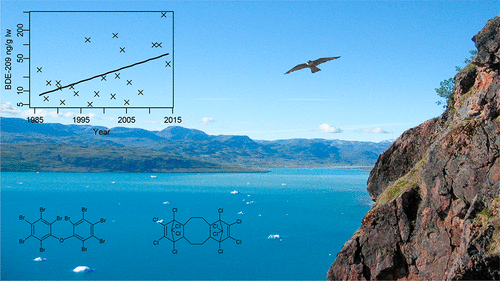Regulated and Unregulated Halogenated Flame Retardants in Peregrine Falcon Eggs from Greenland
New publication by Katrin Vorkamp, Knud Falk, Søren Møller, Frank F. Rigét, and Peter B. Sørensen

Abstract:
Median levels of regulated flame retardants, i.e., polybrominated diphenyl ethers (PBDEs), brominated biphenyl (BB)-153, and hexabromocyclododecane (HBCD), in 33–48 eggs of peregrine falcons (Falco peregrinus) from Greenland were 1909, 359, and 5.98 ng/g lipid weight (lw), respectively, and generally intermediate to levels in North America and Europe. Unregulated flame retardants had lower median concentrations of 1.06 (2-ethylhexyl-2,3,4,5-tetrabromobenzoate, EH-TBB), 2.42 (1,2-bis(2,4,6-tribromophenoxy)-ethane, BTBPE), 0.52 (2,4,6-tribromophenyl 2,3-dibromopropyl ether, DPTE), and 4.78 (dechlorane plus) ng/g lw. Although these compounds are often described as recent replacements for PBDEs, they were also present in eggs from the 1980s. BDE-209 was the only compound with a significant increase (+7.2% annual change) between 1986 and 2014, while BB-153 and DPTE decreased significantly (−8.0% and −2.8% annual change, respectively). Dechlorane plus showed a nonsignificant increase. Individual birds, equipped with light-logging geolocators, confirmed the contaminant exposure over a large geographical area as the birds spent nearly equal time periods in their breeding and wintering grounds in Greenland and Central/South America, respectively, interrupted by 5–6 weeks of migration through North America.
Environ. Sci. Technol., 2018, 52 (2), pp 474–483. DOI: 10.1021/acs.est.7b04866
